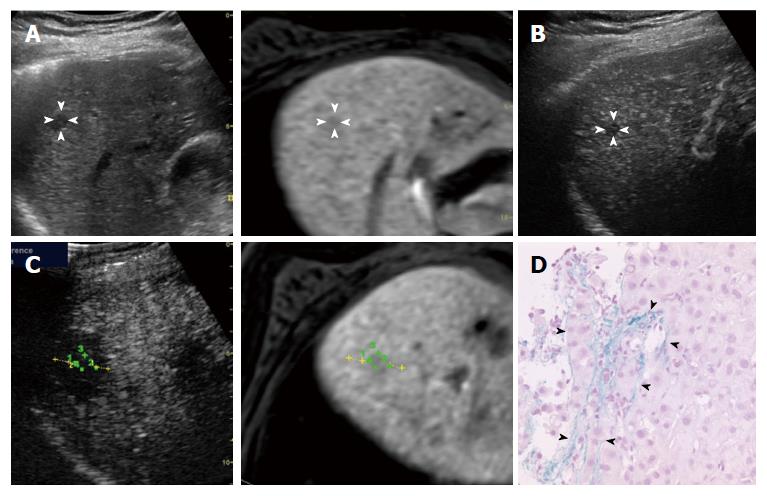Copyright
©The Author(s) 2017.
World J Gastroenterol. May 7, 2017; 23(17): 3111-3121
Published online May 7, 2017. doi: 10.3748/wjg.v23.i17.3111
Published online May 7, 2017. doi: 10.3748/wjg.v23.i17.3111
Figure 2 A 78-year-old man with an early hepatocellular carcinoma lesion (maximum diameter, 11 mm) in segment VIII of the liver.
A: The fusion image combining conventional ultrasonography (US) (left side) and the hepatobiliary phase of contrast-enhanced magnetic resonance imaging (MRI) with Gd-EOB-DTPA (right side) shows the targeted early hepatocellular carcinoma (HCC) lesion (arrowheads), which appears as a hypo-echoic lesion on conventional US and as a slightly hypo-intense area during the hepatobiliary phase; B: A contrast-enhanced US image obtained during the arterial phase shows a hypo-vascular lesion (arrowheads); C: Transcostal fusion imaging, obtained 1 d after radiofrequency ablation (RFA), combining a portal phase of contrast-enhanced US (left side) and a hepatobiliary phase of contrast-enhanced MRI with Gd-EOB-DTPA obtained before RFA as a reference (right side) on a single screen. When evaluated using only contrast-enhanced US, the edge between the ablated HCC and the ablated adjacent liver parenchyma is difficult to identify. Using fusion imaging with GPS marks, we confirmed the edge of the ablated HCC clearly on a portal phase of contrast-enhanced US, and the ablative margin was able to be measured as 5.3 mm (yellow dotted line); D: Victoria blue staining, showing elastic fibers surrounding the portal tract in blue, reveals stromal (portal tract) invasion compatible with a diagnosis of early HCC. The arrowheads indicate the portal tract, and cancer cells are present within the portal tract.
- Citation: Hao Y, Numata K, Ishii T, Fukuda H, Maeda S, Nakano M, Tanaka K. Rate of local tumor progression following radiofrequency ablation of pathologically early hepatocellular carcinoma. World J Gastroenterol 2017; 23(17): 3111-3121
- URL: https://www.wjgnet.com/1007-9327/full/v23/i17/3111.htm
- DOI: https://dx.doi.org/10.3748/wjg.v23.i17.3111









